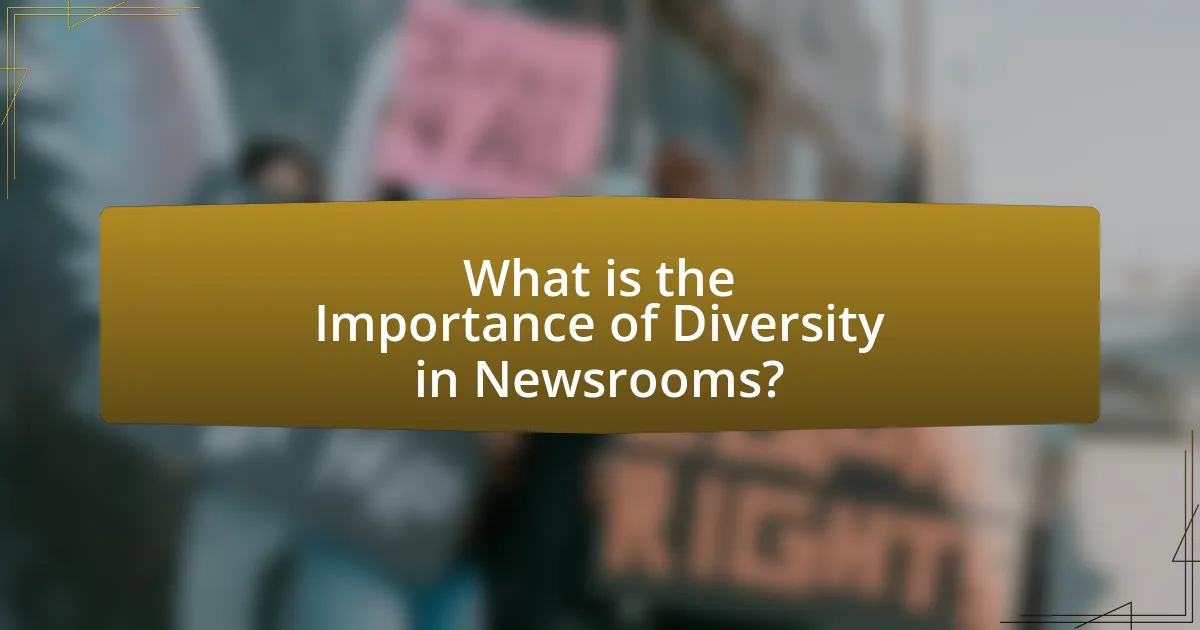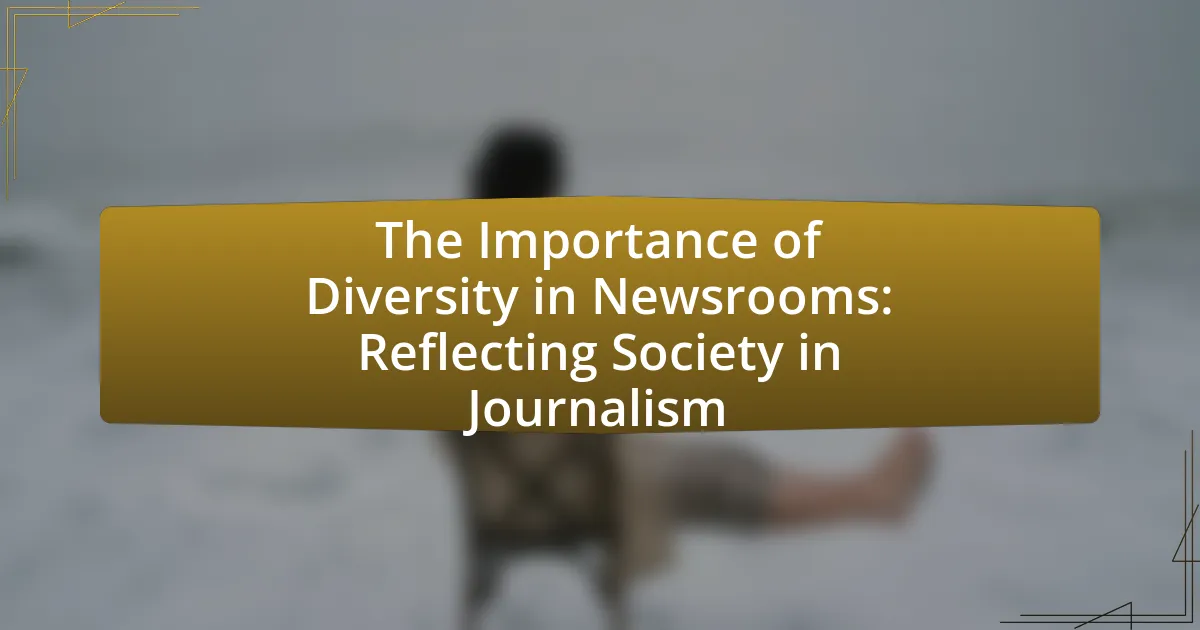The article focuses on the importance of diversity in newsrooms and its critical role in reflecting the multifaceted nature of society in journalism. It highlights how diverse teams enhance the accuracy and comprehensiveness of news coverage by incorporating a wide range of perspectives and experiences. The discussion includes the societal implications of diversity, the challenges faced by newsrooms in achieving it, and the barriers encountered by underrepresented groups. Additionally, it outlines best practices for promoting diversity, the measurable outcomes of diverse newsrooms, and practical steps individuals can take to support diversity in journalism.

What is the Importance of Diversity in Newsrooms?
Diversity in newsrooms is crucial because it ensures that a wide range of perspectives and experiences are represented in journalism. This representation leads to more comprehensive and accurate reporting, which reflects the diverse society in which we live. Research indicates that diverse teams produce better outcomes; for instance, a study by the American Society of News Editors found that news organizations with diverse staff are more likely to cover issues relevant to various communities. Furthermore, diversity fosters innovation and creativity, enhancing the quality of news content and engaging a broader audience.
Why is diversity crucial in journalism?
Diversity is crucial in journalism because it ensures that multiple perspectives are represented, leading to more accurate and comprehensive reporting. A diverse newsroom can better reflect the varied experiences and viewpoints of the audience, which enhances the credibility and relevance of news coverage. Research by the American Society of News Editors indicates that diverse newsrooms produce stories that resonate more with diverse audiences, ultimately fostering trust and engagement. Furthermore, studies show that inclusive reporting can reduce bias and stereotypes, contributing to a more informed public.
What are the societal implications of a diverse newsroom?
A diverse newsroom enhances societal representation and fosters a more inclusive media landscape. This diversity leads to a broader range of perspectives, which can improve the quality of journalism by ensuring that various voices and experiences are reflected in news coverage. Research indicates that diverse teams are more innovative and effective in problem-solving, which can result in more comprehensive reporting that resonates with a wider audience. For instance, a study by the American Society of News Editors found that newsrooms with diverse staff are better at covering issues relevant to minority communities, thereby promoting social equity and understanding.
How does diversity influence news coverage?
Diversity significantly influences news coverage by ensuring a broader range of perspectives and experiences are represented in journalism. When newsrooms include individuals from various backgrounds—such as different races, genders, and socioeconomic statuses—they are more likely to cover stories that resonate with diverse audiences and highlight issues that may otherwise be overlooked. Research from the American Society of News Editors indicates that diverse newsrooms produce more comprehensive and accurate reporting, as they can challenge biases and assumptions that may exist in homogenous teams. This representation not only enriches the content but also fosters trust and engagement among audiences, as they see their realities reflected in the news.
What challenges do newsrooms face in achieving diversity?
Newsrooms face significant challenges in achieving diversity, primarily due to systemic biases, recruitment practices, and retention issues. Systemic biases within the media industry often lead to a lack of representation of marginalized groups, as hiring decisions may favor candidates from similar backgrounds. Recruitment practices can also be limited, as many news organizations rely on traditional networks that may not reach diverse talent pools. Additionally, retention issues arise when diverse employees encounter an unwelcoming workplace culture, leading to higher turnover rates. According to a 2021 report by the American Society of News Editors, only 22% of newsroom employees identified as people of color, highlighting the ongoing struggle for diversity in journalism.
What barriers exist for underrepresented groups in journalism?
Underrepresented groups in journalism face several barriers, including systemic discrimination, lack of access to resources, and limited representation in leadership roles. Systemic discrimination manifests in hiring practices that favor established networks, often excluding diverse candidates. Research from the American Society of News Editors indicates that only 22% of newsroom employees are people of color, highlighting the lack of representation. Additionally, underfunded educational opportunities and mentorship programs further hinder access for these groups, creating a cycle of exclusion. Limited representation in leadership roles perpetuates these barriers, as decision-makers often prioritize perspectives that align with their own experiences, thereby marginalizing diverse voices in news coverage.
How can news organizations address these challenges?
News organizations can address challenges related to diversity by implementing targeted recruitment strategies that prioritize underrepresented groups. For instance, organizations can partner with diverse educational institutions and community organizations to create internship and mentorship programs aimed at attracting a wider range of candidates. Research indicates that diverse newsrooms produce more comprehensive and nuanced reporting, which enhances audience trust and engagement. A study by the American Society of News Editors found that newsrooms with higher diversity levels are more likely to cover a broader spectrum of stories, reflecting the varied experiences of society.

How does Diversity Reflect Society in Journalism?
Diversity in journalism reflects society by ensuring that various perspectives, experiences, and backgrounds are represented in news coverage. This representation is crucial because it allows media outlets to provide a more comprehensive and accurate portrayal of the communities they serve. For instance, a 2021 study by the American Society of News Editors found that newsrooms with diverse staff are more likely to cover issues relevant to underrepresented groups, leading to a richer public discourse. Furthermore, diverse journalism fosters trust among audiences, as people are more likely to engage with media that reflects their own experiences and viewpoints.
In what ways does a diverse newsroom mirror the community?
A diverse newsroom mirrors the community by ensuring representation of various demographics, perspectives, and experiences. This representation allows for more comprehensive coverage of issues that affect different segments of the population, leading to stories that resonate with a broader audience. For instance, research by the American Society of News Editors indicates that newsrooms with diverse staff are more likely to cover topics relevant to minority communities, thereby enhancing public trust and engagement. Additionally, a diverse newsroom fosters a culture of inclusivity, encouraging dialogue and understanding among staff, which ultimately reflects the multifaceted nature of the community it serves.
What are the benefits of having journalists from varied backgrounds?
Having journalists from varied backgrounds enhances the quality and depth of news coverage. This diversity allows for a broader range of perspectives, which leads to more comprehensive storytelling and a better understanding of complex issues. For instance, research by the American Society of News Editors indicates that diverse newsrooms produce content that resonates more with a wider audience, reflecting the multifaceted nature of society. Additionally, journalists from different backgrounds can uncover stories that may be overlooked by a homogenous group, ensuring that marginalized voices are represented in the media. This representation not only enriches the narrative but also fosters trust between the media and the communities they serve.
How does representation affect audience trust in media?
Representation significantly affects audience trust in media by influencing perceptions of credibility and relatability. When media outlets reflect diverse voices and perspectives, audiences are more likely to feel that their experiences and identities are acknowledged, which fosters a sense of trust. Research by the American Press Institute indicates that diverse representation in newsrooms leads to more comprehensive coverage of issues affecting various communities, thereby enhancing the perceived reliability of the information presented. Furthermore, studies show that audiences are more inclined to trust media that they believe understands their cultural context, as evidenced by a 2019 report from the Pew Research Center, which found that 61% of respondents felt that news organizations should reflect the diversity of the communities they serve. This correlation between representation and trust underscores the importance of diversity in journalism for building audience confidence in media.
What role does diversity play in storytelling?
Diversity plays a crucial role in storytelling by enriching narratives and providing varied perspectives that reflect the complexity of society. When storytellers incorporate diverse voices, they create more authentic and relatable content, which resonates with a broader audience. Research indicates that diverse teams produce more innovative ideas and solutions, as evidenced by a McKinsey report showing that companies with higher diversity levels outperform their peers in profitability and value creation. This correlation highlights how diversity not only enhances storytelling but also drives engagement and understanding among different demographic groups.
How can diverse perspectives enhance news narratives?
Diverse perspectives enhance news narratives by providing a more comprehensive understanding of events and issues. When journalists from varied backgrounds contribute, they bring unique insights that reflect the complexities of society, leading to richer storytelling. For instance, a study by the American Press Institute found that diverse newsrooms produce content that resonates more with a broader audience, as it captures different cultural contexts and experiences. This inclusivity not only fosters greater engagement but also promotes accuracy in reporting, as multiple viewpoints help to challenge biases and assumptions, ultimately leading to more balanced and informative news coverage.
What examples illustrate the impact of diversity on reporting?
Diversity in reporting significantly enhances the representation of various perspectives and experiences, leading to more comprehensive news coverage. For instance, the inclusion of journalists from different racial and ethnic backgrounds has been shown to improve the accuracy of reporting on issues affecting those communities. A study by the American Society of News Editors found that diverse newsrooms are more likely to cover stories relevant to underrepresented groups, resulting in a broader understanding of societal issues. Additionally, the coverage of the Black Lives Matter movement was notably influenced by the presence of Black journalists, who provided critical insights and context that mainstream media often overlooked. These examples illustrate how diversity directly impacts the depth and quality of news reporting, ensuring that it reflects the multifaceted nature of society.

What are the Best Practices for Promoting Diversity in Newsrooms?
The best practices for promoting diversity in newsrooms include implementing targeted recruitment strategies, fostering an inclusive workplace culture, and providing ongoing diversity training. Targeted recruitment strategies involve actively seeking candidates from underrepresented communities, which can be supported by partnerships with diverse organizations and educational institutions. Fostering an inclusive workplace culture requires creating an environment where all voices are valued, leading to better representation in storytelling. Ongoing diversity training equips staff with the skills to recognize and combat biases, enhancing the newsroom’s ability to reflect the diverse society it serves. Research by the American Society of News Editors indicates that diverse newsrooms produce more comprehensive and accurate reporting, demonstrating the effectiveness of these practices in achieving diversity goals.
How can news organizations implement effective diversity strategies?
News organizations can implement effective diversity strategies by actively recruiting and retaining a diverse workforce that reflects the demographics of the communities they serve. This can be achieved through targeted outreach programs, partnerships with diverse educational institutions, and mentorship initiatives aimed at underrepresented groups. Research from the American Society of News Editors indicates that diverse newsrooms produce more comprehensive and accurate reporting, as they bring varied perspectives that enhance storytelling and audience engagement. Furthermore, establishing diversity training programs and inclusive workplace policies fosters an environment where all employees feel valued and empowered to contribute, ultimately leading to improved organizational performance and credibility in journalism.
What training programs can support diversity initiatives?
Training programs that can support diversity initiatives include unconscious bias training, cultural competency workshops, and inclusive leadership development programs. Unconscious bias training helps participants recognize and mitigate their biases, which can lead to more equitable decision-making in hiring and promotions. Cultural competency workshops enhance understanding and appreciation of diverse backgrounds, fostering an inclusive workplace environment. Inclusive leadership development programs equip leaders with the skills to create and sustain diverse teams, ultimately improving organizational performance and innovation. Research shows that organizations with diverse leadership teams are 35% more likely to outperform their peers in profitability, highlighting the effectiveness of these training programs in promoting diversity initiatives.
How can mentorship programs foster diversity in journalism?
Mentorship programs can foster diversity in journalism by providing underrepresented individuals with guidance, resources, and networking opportunities essential for career advancement. These programs connect aspiring journalists from diverse backgrounds with experienced professionals who can offer insights into navigating the industry, thereby breaking down barriers to entry. Research indicates that mentorship significantly increases the likelihood of minority journalists securing positions in newsrooms, as evidenced by a 2019 study from the American Society of News Editors, which found that mentorship initiatives led to a 30% increase in the hiring of journalists from diverse backgrounds. By actively promoting inclusivity and supporting the professional development of diverse talent, mentorship programs play a crucial role in creating a more representative media landscape.
What are the measurable outcomes of diversity in newsrooms?
Diversity in newsrooms leads to improved representation, enhanced creativity, and increased audience engagement. Research indicates that diverse teams produce more comprehensive news coverage, as they bring varied perspectives that reflect the complexities of society. For instance, a study by the American Society of News Editors found that newsrooms with higher diversity levels are more likely to cover issues relevant to underrepresented communities, resulting in a broader audience reach. Additionally, diverse teams have been shown to foster innovation; a report from McKinsey & Company highlights that companies with diverse workforces are 35% more likely to outperform their peers in profitability. These measurable outcomes underscore the critical role diversity plays in journalism, ultimately enriching the quality and relevance of news content.
How can newsrooms assess the impact of diversity on their work?
Newsrooms can assess the impact of diversity on their work by analyzing audience engagement metrics, content representation, and staff demographics. Audience engagement metrics, such as social media interactions and readership statistics, can reveal how diverse perspectives resonate with different community segments. Content representation can be evaluated by examining the diversity of sources and subjects featured in stories, ensuring that various voices are included. Additionally, analyzing staff demographics helps identify gaps in representation within the newsroom itself, which can influence editorial decisions and coverage. Research indicates that diverse teams produce more innovative and comprehensive journalism, as shown in a 2018 study by McKinsey & Company, which found that companies with higher diversity levels are 35% more likely to outperform their peers in profitability.
What metrics should be used to evaluate diversity efforts?
To evaluate diversity efforts in newsrooms, key metrics include demographic representation, retention rates, recruitment diversity, and employee engagement scores. Demographic representation measures the percentage of employees from various backgrounds compared to the community served, ensuring alignment with societal diversity. Retention rates assess how well diverse employees are supported and integrated within the organization, indicating the effectiveness of inclusion strategies. Recruitment diversity tracks the variety of candidates sourced during hiring processes, reflecting the commitment to attracting a broad talent pool. Employee engagement scores gauge the satisfaction and sense of belonging among diverse staff, providing insight into the workplace culture. These metrics collectively offer a comprehensive view of diversity efforts and their impact on newsroom dynamics.
What practical steps can individuals take to support diversity in journalism?
Individuals can support diversity in journalism by actively seeking out and promoting diverse voices and perspectives in media. This can be achieved by subscribing to and sharing publications that prioritize diverse content, such as those led by underrepresented groups. Additionally, individuals can engage with and support initiatives that aim to increase diversity in journalism, such as mentorship programs for aspiring journalists from marginalized backgrounds. Research indicates that diverse newsrooms produce more comprehensive and accurate reporting, as highlighted in a 2018 study by the American Society of News Editors, which found that diverse teams are better at understanding and covering the needs of varied communities.

Leave a Reply